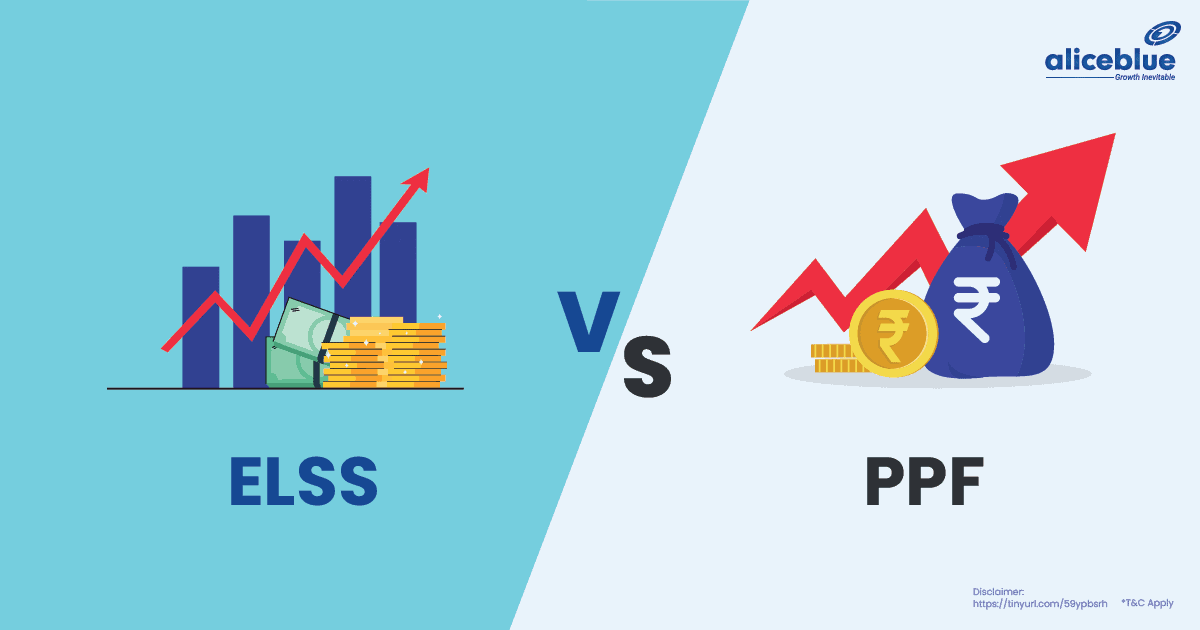The main difference between ELSS (Equity Linked Savings Scheme) and PPF (Public Provident Fund) is that ELSS is a market-linked investment, offering potentially higher returns with more risk and has tax-saving benefits, while PPF provides fixed, risk-free returns, tax exemptions, and a longer lock-in period.
Content:
- ELSS Meaning
- What is a Public Provident Fund?
- Difference Between ELSS And PPF
- ELSS Vs PPF – Quick Summary
- Difference Between PPF And ELSS – FAQs
ELSS Meaning
Equity Linked Savings Scheme (ELSS) is a type of mutual fund investment in India that primarily invests in equities, with tax benefits under Section 80C of the Income Tax Act. It offers potential high returns, has a three-year lock-in period, and carries market-related risks.
ELSS, or Equity Linked Savings Scheme, is a mutual fund that invests predominantly in the stock market. It’s a popular choice for investors seeking growth through equity exposure alongside tax-saving benefits.
These schemes have a minimum lock-in period of three years, the shortest among tax-saving options under Section 80C. However, being equity-oriented, ELSS funds carry higher risk compared to other tax-saving investments like PPFs or FDs.
For example: If you invest Rs 50,000 in an ELSS fund, this amount is deductible from your taxable income under Section 80C. The investment, subject to market risks, has potential for growth over three years.

What is a Public Provident Fund?
A Public Provident Fund (PPF) is a long-term savings scheme in India, offering tax-free returns and benefits under Section 80C of the Income Tax Act. It has a 15-year lock-in period and provides a fixed, government-guaranteed interest rate on deposits.
Public Provident Fund (PPF) is a government-backed investment vehicle, known for its safety and steady returns. It’s a popular choice for risk-averse individuals seeking stable growth with tax benefits.
PPF accounts have a maturity period of 15 years, extendable in blocks of 5 years. Interest earned and the principal are exempt from tax, making it an attractive option for long-term, tax-efficient savings.
For example: If you invest Rs 1,00,000 annually in a PPF account, you can avail of tax deductions on this amount under Section 80C. After 15 years, this investment grows with tax-free interest, ensuring a secure return.
Difference Between ELSS And PPF
The main difference between ELSS and PPF is that ELSS is market-linked, offering potentially higher but riskier returns with tax benefits. In contrast, PPF ensures fixed, secure returns with tax exemptions and entails a longer commitment period.
| Feature | ELSS (Equity Linked Savings Scheme) | PPF (Public Provident Fund) |
| Investment Type | Equity-oriented mutual fund | Government-backed savings scheme |
| Risk | Higher, linked to stock market performance | Low, with guaranteed returns |
| Returns | Potentially higher but variable, dependent on the market | Fixed, assured returns set by the government |
| Lock-in Period | 3 years | 15 years, extendable in 5-year blocks |
| Tax Benefits | Deductions under Section 80C; Long-term capital gains tax | Deductions under Section 80C; tax-free returns |
| Liquidity | Moderate, post lock-in period | Low, limited withdrawal options pre-maturity |

ELSS Vs PPF – Quick Summary
- The main difference is that ELSS targets equity markets, promising potentially higher but riskier returns, while PPF is a secure, government-supported scheme offering stable, guaranteed returns with a longer commitment period.
- ELSS, an Indian mutual fund scheme, primarily invests in equities and offers tax deductions under Section 80C. It may offer high returns but involves a three-year lock-in and inherent market risks.
- PPF is a savings option in India with a 15-year commitment, providing fixed, assured interest backed by the government. It offers tax-exempt earnings and qualifies for Section 80C benefits under the Income Tax Act.
Open free demat account with Alice Blue in 15 minutes today! Invest in Stocks, Mutual Funds, Bonds & IPOs for Free. Also, trade at just ₹ 15/order and save 33.33% brokerage on every order.
Difference Between PPF And ELSS – FAQs
What Is the Difference between ELSS and PPF?
The main difference is that ELSS funds invest in equities with potentially higher returns but more risk, while PPF offers fixed, lower-risk returns, backed by the government, with a longer lock-in period.
What is meant by PPF?
PPF, or Public Provident Fund, is a long-term savings instrument in India, that offers tax benefits and guaranteed returns. It’s government-backed, features a 15-year lock-in period, and is ideal for risk-averse investors.
What are the benefits of a PPF account?
PPF accounts offer safe, guaranteed returns with a stable interest rate, tax-exempt earnings, and deductions under Section 80C. They provide long-term savings growth, are government-backed, and are suitable for risk-averse individuals.
What is the maximum limit of ELSS?
The maximum investment limit for ELSS isn’t capped by the scheme itself, but tax deductions under Section 80C of the Income Tax Act are limited to Rs 1.5 lakh annually for these investments.
Can I invest in both PPF and ELSS?
Yes, you can invest in both PPF and ELSS. This diversifies your portfolio, combining PPF’s low-risk, stable returns with ELSS’s higher-risk, potentially higher-return equity investments, and both offer tax benefits under Section 80C.
Is ELSS completely tax-free?
ELSS investments are not completely tax-free. While they offer tax deductions under Section 80C on investments up to Rs 1.5 lakh, the returns are subject to Long Term Capital Gains (LTCG) tax if they exceed Rs 1 lakh.
Who should not invest in ELSS?
Individuals who dislike market risks, need short-term liquidity or are uncomfortable with the mandatory three-year lock-in period should avoid investing in ELSS, as it involves equity market exposure and a fixed lock-in duration.






